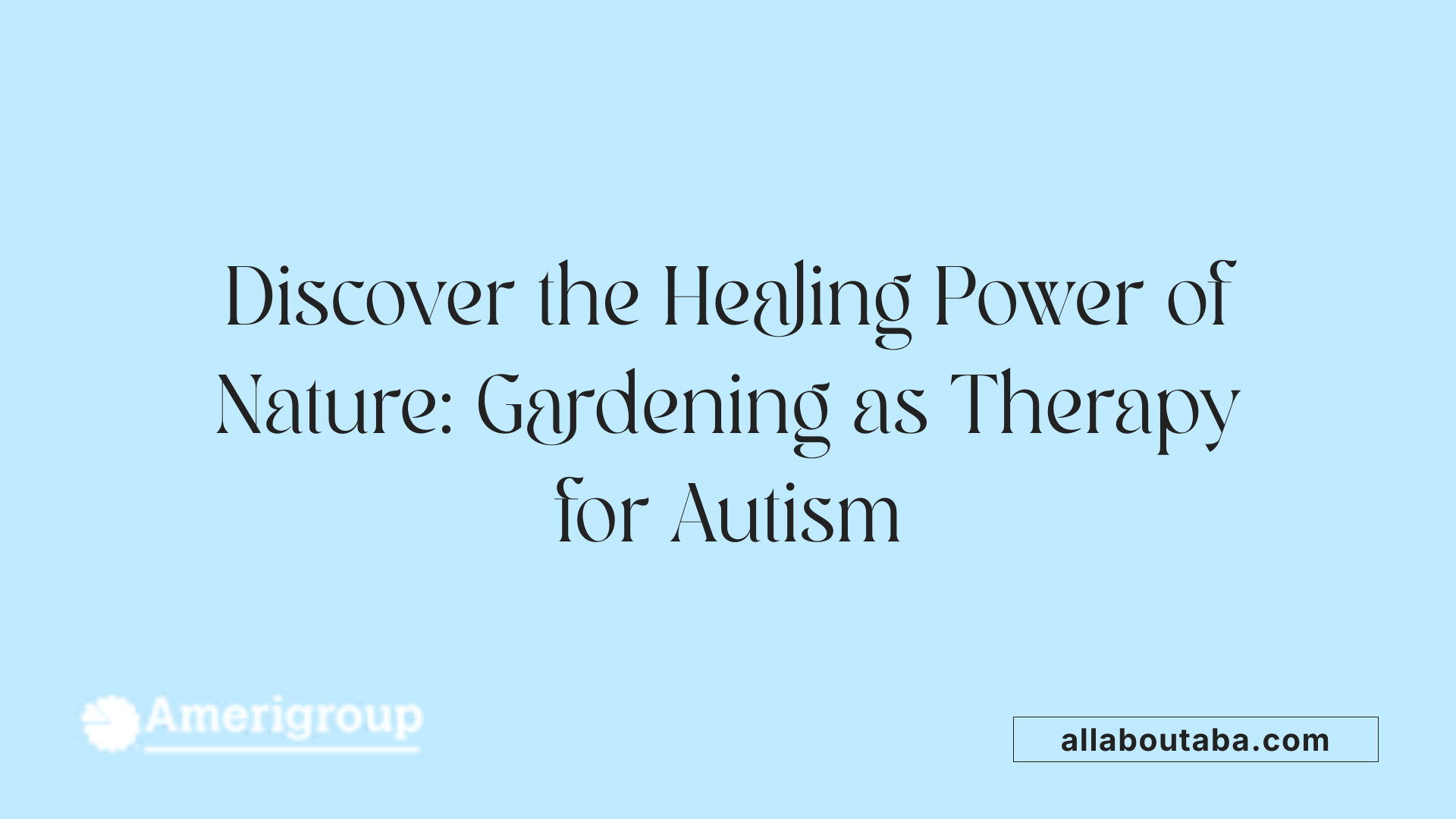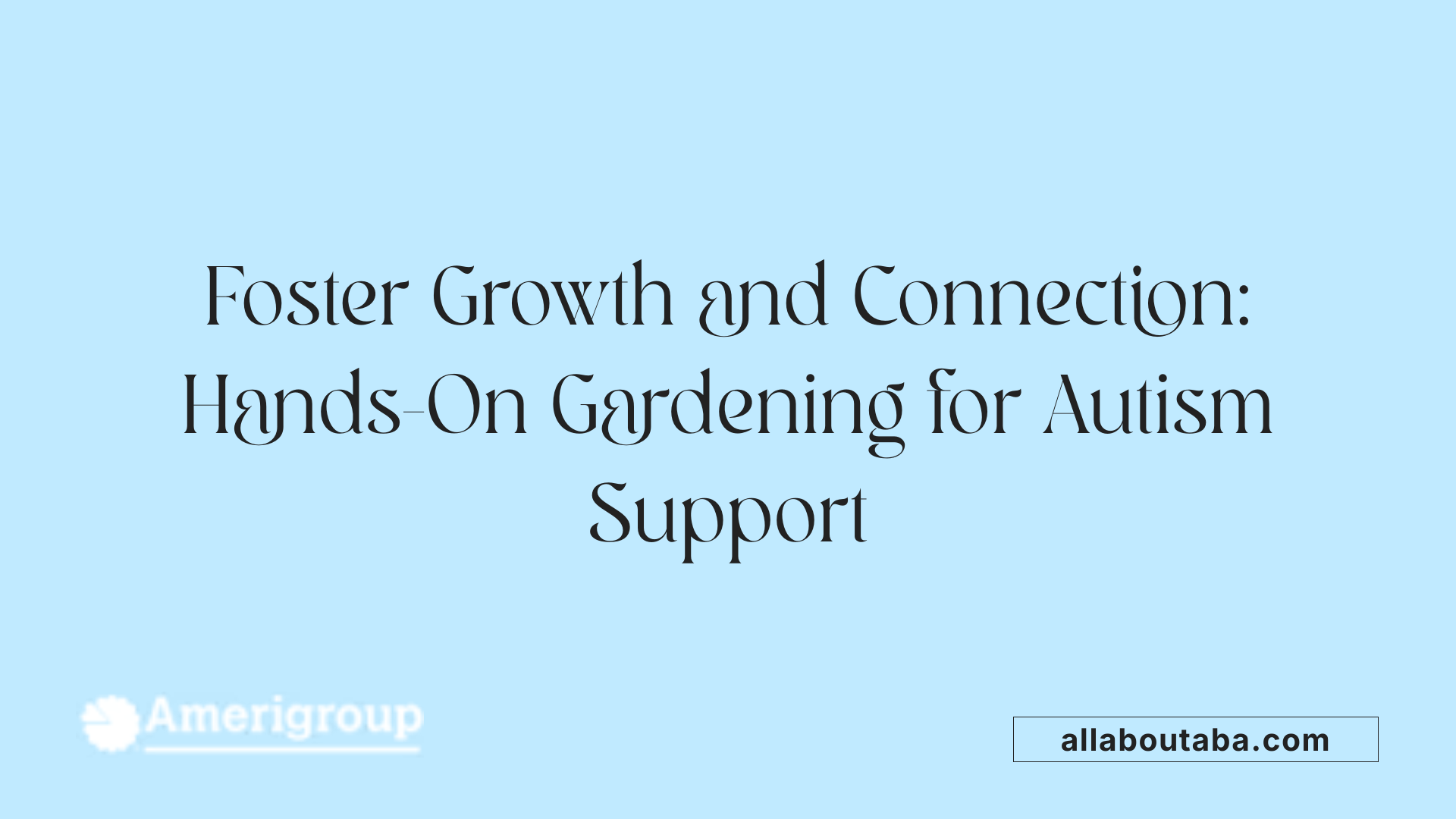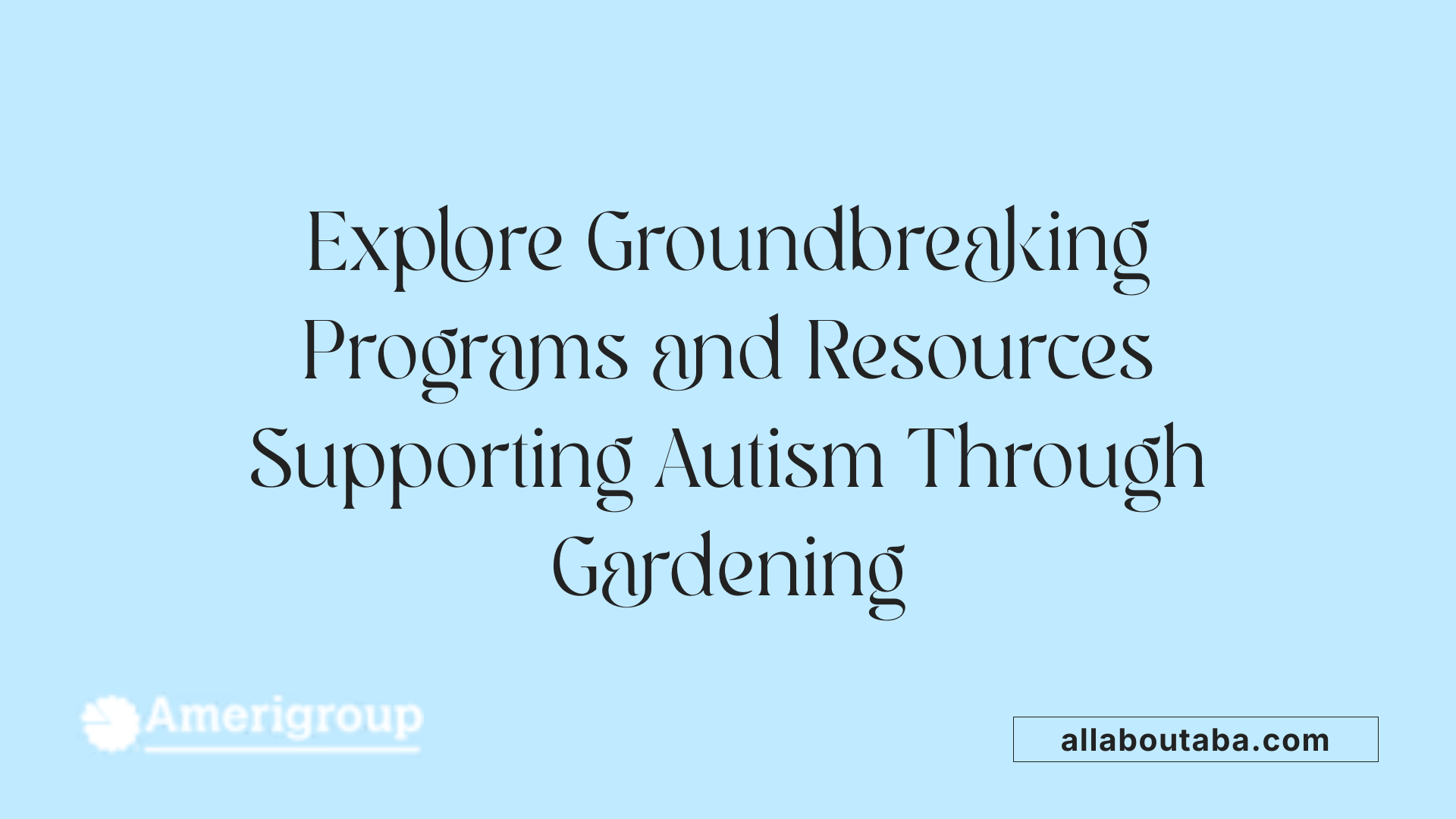Connecting Nature and Social Growth in Autism
Gardening clubs have emerged as valuable initiatives for supporting the development of children and individuals with autism. By engaging participants in routine-based, sensory-rich environments, these clubs foster social, emotional, and cognitive growth. This article explores how gardening serves as a therapeutic tool, the role of sensory gardens and horticultural therapy, and highlights evidence and programs demonstrating the positive impact of gardening on autism social development.
The Therapeutic Power of Gardening for Autism

What are the benefits of gardening clubs for children and individuals with autism?
Gardening clubs provide a nurturing environment where children and individuals with autism can develop essential social and communication skills. Through routine activities such as planting, watering, and caring for plants, participants learn to work collaboratively and share responsibilities, fostering teamwork and patience.
These clubs also support emotional regulation by creating calm, predictable spaces grounded in nature. The tactile experience of touching soil and plants, along with observing growth, helps improve sensory processing and reduces sensory sensitivities.
Participation in gardening promotes physical health by encouraging movement and coordination, while cognitively, it enhances understanding of science, nutrition, and responsibility. The process of nurturing plants boosts confidence and provides a sense of achievement, which can improve overall emotional well-being.
Studies show that engaging with a garden setting can decrease anxiety and stress levels, providing a therapeutic escape from more overstimulating environments. Sensory experiences like sniffing fragrant herbs or feeling different textures improve sensory integration.
Overall, gardening clubs serve as valuable tools for fostering growth across various developmental areas, making a significant difference in the social, emotional, and sensory lives of children and individuals with autism.
How gardening activities help reduce anxiety and sensory sensitivities
Gardening activities promote relaxation and reduce stress by immersing individuals in a peaceful natural environment. The structured routines involved—planting, watering, harvesting—offer predictability that can calm anxious feelings.
Sensory sensitivities, common among autistic individuals, are gradually addressed through controlled exposure to different textures, smells, and sights. For example, touching smooth leaves or smelling aromatic herbs can increase comfort levels over time.
Sensory gardens, equipped with features like water walls, swings, and calming color schemes, are designed to balance alerting and calming stimuli. These environments help children process sensory data more effectively, reducing avoidance behaviors and improving overall sensory integration.
Therapeutic activities like these also encourage mindfulness and emotional regulation, which can lessen tension and promote a balanced mood.
Physical health, cognitive growth, and emotional well-being benefits
Gardening supports physical development by strengthening muscles, improving coordination, and enhancing motor skills through activities such as digging, planting, and harvesting.
Cognitively, gardening enhances concentration, memory, and problem-solving skills, especially when children learn about plant growth, nutrition, and ecosystems firsthand.
Emotionally, nurturing plants fosters patience, confidence, and a sense of self-worth. The tangible progress of seeing plants grow provides motivation and boosts self-esteem.
These activities also offer a break from traditional classroom or clinical settings, encouraging outdoor engagement and physical activity, which are vital for overall health.
Tables summarizing these benefits are provided below:
| Benefit Area | Examples | Additional Notes |
|---|---|---|
| Social Skills | Teamwork, sharing responsibilities | Promotes communication and collaboration |
| Sensory Development | Touching, smelling, observing | Enhances sensory integration |
| Physical Health | Motor skills, strength, coordination | Improves overall fitness |
| Emotional Well-being | Patience, confidence, relaxation | Reduces stress and anxiety |
| Activities | Outcomes | Tools/Features |
|---|---|---|
| Planting & Harvesting | Cognitive growth, motor skills | Trowels, watering cans, raised beds |
| Sensory Exercises | Reduce sensory sensitivities | Fragrant herbs, textured plant leaves |
| Routine Management | Emotional regulation, independence | Scheduled tasks, visual routines |
Incorporating gardening into therapeutic and educational frameworks provides a holistic approach to supporting children and individuals with autism, enriching their physical, cognitive, and emotional lives.
Supporting Social and Cognitive Development Through Hands-On Gardening

How can gardening serve as a therapeutic activity to support social, emotional, and cognitive development in autism?
Gardening offers a meaningful way to support individuals with autism by engaging multiple senses and fostering calmness. The tactile experience of working with soil, plants, and water can help reduce sensory sensitivities and ease anxiety. These activities also promote social interaction through group tasks like planting, watering, and harvesting, encouraging communication, cooperation, and teamwork.
Creating a structured environment with routines and predictable patterns makes gardening a comforting activity that reduces stress. As children and adults nurture plants, they experience a sense of achievement and confidence, which can positively influence emotional well-being.
Cognitive improvements are evident as participants learn to follow multi-step instructions, develop focus, and refine both fine and gross motor skills. Hands-on tasks such as planting seeds, watering plants, or harvesting vegetables help enhance concentration, dexterity, and physical coordination.
Research shows that horticultural therapy helps children with autism develop social skills, improve sensory processing, and adapt to new challenges. Spaces designed with sensory considerations—featuring calming and alerting elements—support emotional regulation and provide safe environments for exploration.
Overall, gardening not only nurtures plants but also promotes personal growth, social connection, and emotional health for individuals on the autism spectrum, making it a valuable therapeutic tool.
Horticultural Therapy and Sensory Gardens in Autism Support

What is the role of horticultural therapy and sensory gardens in improving social skills for people with autism?
Horticultural therapy, widely recognized as autism gardening therapy, has shown remarkable effects on physical, social, sensory, and emotional health of individuals with autism. Engaging in gardening activities helps children and adults develop essential skills such as communication, teamwork, and emotional regulation. Sensory gardens are specially designed outdoor spaces that incorporate a variety of sensory experiences—visual, tactile, olfactory, and auditory—to support sensory processing and reduce anxiety.
These gardens serve as safe environments where individuals can explore different textures, smells, sounds, and sights. This multisensory stimulation helps improve focus, relaxation, and the ability to process sensory information more effectively. Design features often include accessible pathways, calm zones, water features, musical elements, and textured plantings. Such thoughtful features foster opportunities for interaction, collaboration, and shared activities, enhancing social connections.
Participation in gardening tasks like planting, watering, and harvesting encourages communication and cooperation. These activities boost confidence and establish a sense of achievement, leading to better social engagement.
Overall, horticultural therapy and sensory gardens create inclusive, therapeutic environments that support social and emotional development, helping individuals with autism build vital life skills in a nurturing setting.
Research, Programs, and Resources Supporting Gardening in Autism Development

What evidence exists to show that gardening promotes social engagement and development in autistic populations?
Research highlights the benefits of gardening and nature-based activities for children and adolescents with autism. Multiple studies and reviews have documented improvements in social, communication, and adaptive behaviors resulting from participation in gardening programs.
For example, group gardening activities like horticultural therapy have shown to foster social interaction, teamwork, and emotional well-being. These programs often use standardized tools such as the Vineland Social Maturity Scale to measure growth. Participants often experience increased confidence, reduced anxiety, and better sensory integration.
Engaging in tasks like planting, caring for plants, and working in community gardens encourages cooperation and communication. These experiences support holistic development by improving social skills and emotional regulation. Overall, evidence suggests that gardening can be a valuable, accessible tool for helping autistic individuals develop stronger social connections and independence.
Are there programs or resources that demonstrate the positive impact of gardening on social development in autism?
Yes, several initiatives and resources actively utilize gardening to support autism development. Many therapeutic gardens and school-based garden projects have documented positive outcomes in fostering social skills, independence, and emotional health.
Sensory gardens, specifically designed for children with ASD, offer calming yet stimulating environments that encourage social interaction and sensory processing. These spaces often include features like water walls, swings, and tactile plants that help children engage comfortably.
Organizations and therapists develop tailored gardening routines that promote communication, cooperation, and life skills. Parental and teacher involvement in structured gardening activities further enhances these outcomes.
Programs like the Sensory Arts Garden at the Els Center of Excellence exemplify how landscape design and sensory features support emotional regulation and social engagement. Overall, these initiatives show that gardening can be a powerful element within comprehensive autism support strategies.
Examples of Success Stories
One notable example is the Biodiversity Custodians program in Italy, where youth with autism involved in caring for gardens demonstrated significant improvements in independence, social interactions, and adaptive behavior.
Similarly, schools like Shrub Oak International use their on-site gardens as dynamic learning environments, helping students develop new skills, improve social interactions, and experience therapeutic benefits.
In vocational settings such as Growing Solutions Farm, gardening activities teach practical life skills like time management, teamwork, and appropriate work attire, contributing to increased independence for adults with autism.
These stories exemplify how access to therapeutic gardening fosters not only individual growth but also community integration and a sense of achievement. Their success underscores the importance of integrating gardening into autism support programs.
| Program/Resource | Focus Area | Impact | Location |
|---|---|---|---|
| Biodiversity Custodians | Social skills, independence | Improved interaction, adaptive behavior | Italy |
| Els Center Sensory Garden | Sensory integration, emotional regulation | Reduced stress, increased social engagement | USA |
| Shrub Oak International | Skills development, therapy | Enhanced learning, social development | USA |
| Growing Solutions Farm | Vocational skills | Increased independence and confidence | USA |
Gardening initiatives continue to expand as evidence grows of their positive influence on social, emotional, and developmental aspects of life for individuals with autism.
Cultivating Growth and Well-Being Through Gardening
The evidence and diverse programs supporting gardening as a therapeutic and developmental tool underscore its vital role in fostering social skills, emotional resilience, and cognitive abilities among individuals with autism. Gardening clubs, sensory gardens, and horticultural therapy initiatives create inclusive, engaging environments where children and adults can connect with nature, build meaningful relationships, and develop essential life skills. As awareness of these benefits grows, integrating gardening activities into educational, therapeutic, and community settings can profoundly enhance the lives of those with autism, helping them flourish both socially and emotionally.
References
- Benefits of Gardening for Childhood Autism
- Growth in the Garden: A Therapeutic and Educational Tool ...
- Horticultural Therapy Activities can Reduce Stress and ...
- Benefits of Gardening in Special Needs Population
- The Remarkable Ways Sensory Gardens Can Help People ...
- Research Digest: Gardening
- Gardening and Autism, a Match Made in Heaven







